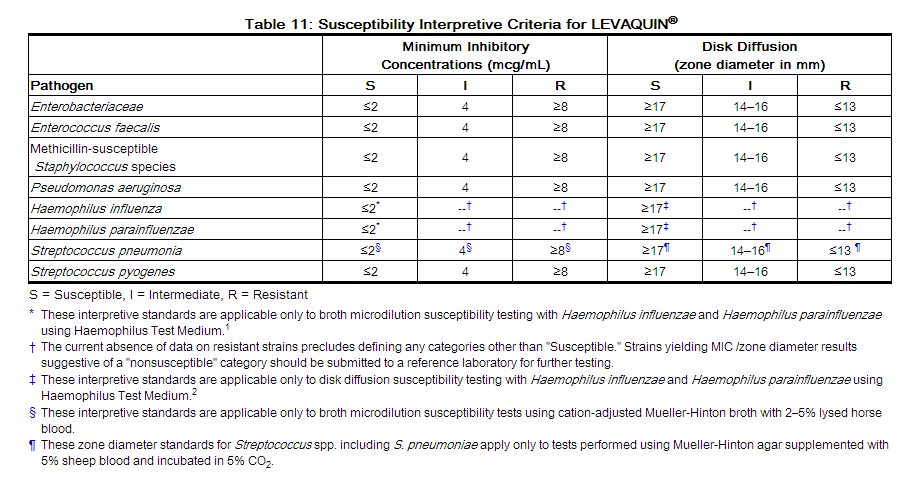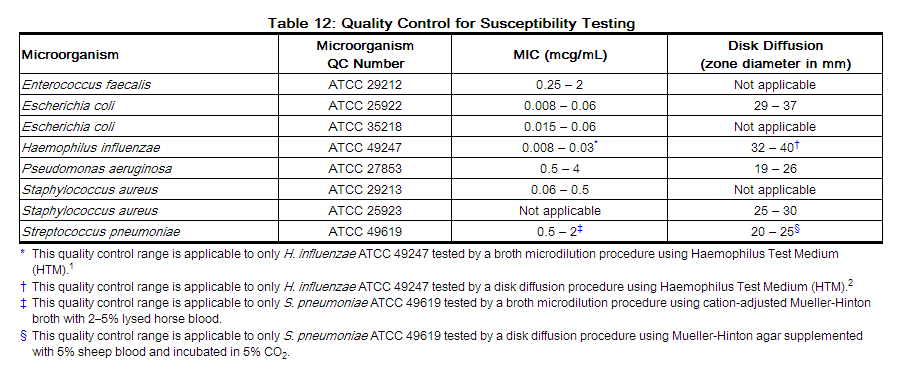Levofloxacin microbiology
Template:Levofloxacin Editor-In-Chief: C. Michael Gibson, M.S., M.D. [1];Associate Editor(s)-in-Chief: Abdurahman Khalil, M.D. [2]
Microbiology
Mechanism of Action
Levofloxacin is the L-isomer of the racemate, ofloxacin, a quinolone antimicrobial agent. The antibacterial activity of ofloxacin resides primarily in the L-isomer. The mechanism of action of levofloxacin and other fluoroquinolone antimicrobials involves inhibition of bacterial topoisomerase IV and DNA gyrase (both of which are type II topoisomerases), enzymes required for DNA replication, transcription, repair and recombination.
Drug Resistance
Fluoroquinolone resistance can arise through mutations in defined regions of DNA gyrase or topoisomerase IV, termed the Quinolone-Resistance Determining Regions (QRDRs), or through altered efflux.
Fluoroquinolones, including levofloxacin, differ in chemical structure and mode of action from aminoglycosides, macrolides and β-lactam antibiotics, including penicillins. Fluoroquinolones may, therefore, be active against bacteria resistant to these antimicrobials.
Resistance to levofloxacin due to spontaneous mutation in vitro is a rare occurrence (range: 10-9 to 10-10). Although cross-resistance has been observed between levofloxacin and some other fluoroquinolones, some microorganisms resistant to other fluoroquinolones may be susceptible to levofloxacin.
Activity in vitro and in vivo
Levofloxacin has in vitro activity against a wide range of Gram-negative and Gram-positive microorganisms.
Levofloxacin is often bactericidal at concentrations equal to or slightly greater than inhibitory concentrations.
Levofloxacin has been shown to be active against most strains of the following microorganisms both in vitro and in clinical infections as described inIndications and Usage (1):
Aerobic Gram-Positive Microorganisms
Enterococcus faecalis (many strains are only moderately susceptible)
Staphylococcus aureus (methicillin-susceptible strains)
Staphylococcus epidermidis (methicillin-susceptible strains)
Streptococcus pneumoniae (including multi-drug resistant strains [MDRSP])1)
1 MDRSP (Multi-drug resistant Streptococcus pneumoniae) isolates are strains resistant to two or more of the following antibiotics: penicillin (MIC ≥2 mcg/mL), 2nd generation cephalosporins, e.g., cefuroxime; macrolides, tetracyclines and trimethoprim/sulfamethoxazole.
Aerobic Gram-Negative Microorganisms
Serratia marcescens
2 As with other drugs in this class, some strains of Pseudomonas aeruginosa may develop resistance fairly rapidly during treatment with LEVAQUIN®.
Other Microorganisms
Levofloxacin has been shown to be active against Bacillus anthracis both in vitro and by use of plasma levels as a surrogate marker in a rhesus monkey model for anthrax (post-exposure) [see Indications and Usage (1.13), Clinical Studies (14.9)].
The following in vitro data are available, but their clinical significance is unknown: Levofloxacin exhibits in vitro minimum inhibitory concentrations (MIC values) of 2 mcg/mL or less against most (≥90%) strains of the following microorganisms; however, the safety and effectiveness of LEVAQUIN® in treating clinical infections due to these microorganisms have not been established in adequate and well-controlled trials.
Aerobic Gram-Positive Microorganisms
β-hemolytic Streptococcus (Group C/F)
β-hemolytic Streptococcus (Group G)
Aerobic Gram-Negative Microorganisms
Bordetella pertussis
Klebsiella oxytoca
Morganella morganii
Pantoea agglomerans
Proteus vulgaris
Providencia stuartii
Pseudomonas fluorescens
Anaerobic Gram-Positive Microorganisms Clostridium perfringens
Susceptibility Tests
Susceptibility testing for levofloxacin should be performed, as it is the optimal predictor of activity.
Dilution techniques:
Quantitative methods are used to determine antimicrobial minimal inhibitory concentrations (MIC values). These MIC values provide estimates of the susceptibility of bacteria to antimicrobial compounds. The MIC values should be determined using a standardized procedure. Standardized procedures are based on a dilution method1 (broth or agar) or equivalent with standardized inoculum concentrations and standardized concentrations of levofloxacin powder. The MIC values should be interpreted according to the criteria outlined in Table 11.
Diffusion techniques:
Quantitative methods that require measurement of zone diameters also provide reproducible estimates of the susceptibility of bacteria to antimicrobial compounds. One such standardized procedure2 requires the use of standardized inoculum concentrations. This procedure uses paper disks impregnated with 5 mcg levofloxacin to test the susceptibility of microorganisms to levofloxacin.
Reports from the laboratory providing results of the standard single-disk susceptibility test with a 5 mcg levofloxacin disk should be interpreted according the criteria outlined in Table 11. Interpretation involves correlation of the diameter obtained in the disk test with the MIC for levofloxacin.
A report of Susceptible indicates that the pathogen is likely to be inhibited if the antimicrobial compound in the blood reaches the concentrations usually achievable. A report of Intermediate indicates that the result should be considered equivocal, and, if the microorganism is not fully susceptible to alternative, clinically feasible drugs, the test should be repeated. This category implies possible clinical applicability in body sites where the drug is physiologically concentrated or in situations where a high dosage of drug can be used. This category also provides a buffer zone which prevents small uncontrolled technical factors from causing major discrepancies in interpretation. A report of Resistant indicates that the pathogen is not likely to be inhibited if the antimicrobial compound in the blood reaches the concentrations usually achievable; other therapy should be selected.
Quality Control:
Standardized susceptibility test procedures require the use of laboratory control microorganisms to control the technical aspects of the laboratory procedures. For dilution technique, standard levofloxacin powder should give the MIC values provided in Table 12. For diffusion technique, the 5 mcg levofloxacin disk should provide zone diameters provided in Table 12.
Carcinogenesis, Mutagenesis, Impairment of Fertility
In a lifetime bioassay in rats, levofloxacin exhibited no carcinogenic potential following daily dietary administration for 2 years; the highest dose (100 mg/kg/day) was 1.4 times the highest recommended human dose (750 mg) based upon relative body surface area. Levofloxacin did not shorten the time to tumor development of UV-induced skin tumors in hairless albino (Skh-1) mice at any levofloxacin dose level and was therefore not photo-carcinogenic under conditions of this study. Dermal levofloxacin concentrations in the hairless mice ranged from 25 to 42 mcg/g at the highest levofloxacin dose level (300 mg/kg/day) used in the photo-carcinogenicity study. By comparison, dermal levofloxacin concentrations in human subjects receiving 750 mg of LEVAQUIN® averaged approximately 11.8 mcg/g at Cmax.
Levofloxacin was not mutagenic in the following assays: Ames bacterial mutation assay (S. typhimurium and E. coli), CHO/HGPRT forward mutation assay, mouse micronucleus test, mouse dominant lethal test, rat unscheduled DNA synthesis assay, and the mouse sister chromatid exchange assay. It was positive in the in vitro chromosomal aberration (CHL cell line) and sister chromatid exchange (CHL/IU cell line) assays.
Levofloxacin caused no impairment of fertility or reproductive performance in rats at oral doses as high as 360 mg/kg/day, corresponding to 4.2 times the highest recommended human dose based upon relative body surface area and intravenous doses as high as 100 mg/kg/day, corresponding to 1.2 times the highest recommended human dose based upon relative body surface area.

